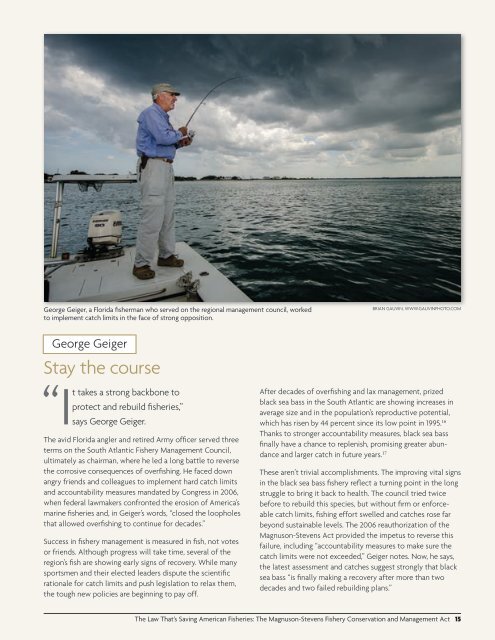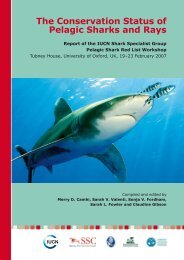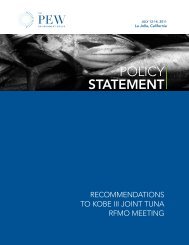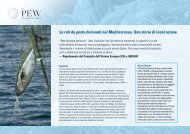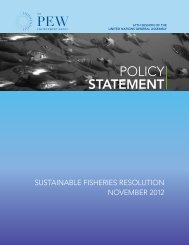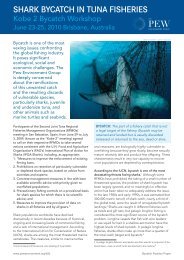The Law That's Saving American Fisheries - Ocean Conservancy
The Law That's Saving American Fisheries - Ocean Conservancy
The Law That's Saving American Fisheries - Ocean Conservancy
You also want an ePaper? Increase the reach of your titles
YUMPU automatically turns print PDFs into web optimized ePapers that Google loves.
George Geiger, a Florida fisherman who served on the regional management council, worked<br />
to implement catch limits in the face of strong opposition.<br />
Brian Gauvin, www.GAUVINPHOTO.COM<br />
George Geiger<br />
Stay the course<br />
“It takes a strong backbone to<br />
protect and rebuild fisheries,”<br />
says George Geiger.<br />
<strong>The</strong> avid Florida angler and retired Army officer served three<br />
terms on the South Atlantic Fishery Management Council,<br />
ultimately as chairman, where he led a long battle to reverse<br />
the corrosive consequences of overfishing. He faced down<br />
angry friends and colleagues to implement hard catch limits<br />
and accountability measures mandated by Congress in 2006,<br />
when federal lawmakers confronted the erosion of America’s<br />
marine fisheries and, in Geiger’s words, “closed the loopholes<br />
that allowed overfishing to continue for decades.”<br />
Success in fishery management is measured in fish, not votes<br />
or friends. Although progress will take time, several of the<br />
region’s fish are showing early signs of recovery. While many<br />
sportsmen and their elected leaders dispute the scientific<br />
rationale for catch limits and push legislation to relax them,<br />
the tough new policies are beginning to pay off.<br />
After decades of overfishing and lax management, prized<br />
black sea bass in the South Atlantic are showing increases in<br />
average size and in the population’s reproductive potential,<br />
which has risen by 44 percent since its low point in 1995. 16<br />
Thanks to stronger accountability measures, black sea bass<br />
finally have a chance to replenish, promising greater abundance<br />
and larger catch in future years. 17<br />
<strong>The</strong>se aren’t trivial accomplishments. <strong>The</strong> improving vital signs<br />
in the black sea bass fishery reflect a turning point in the long<br />
struggle to bring it back to health. <strong>The</strong> council tried twice<br />
before to rebuild this species, but without firm or enforceable<br />
catch limits, fishing effort swelled and catches rose far<br />
beyond sustainable levels. <strong>The</strong> 2006 reauthorization of the<br />
Magnuson-Stevens Act provided the impetus to reverse this<br />
failure, including “accountability measures to make sure the<br />
catch limits were not exceeded,” Geiger notes. Now, he says,<br />
the latest assessment and catches suggest strongly that black<br />
sea bass “is finally making a recovery after more than two<br />
decades and two failed rebuilding plans.”<br />
<strong>The</strong> <strong>Law</strong> That’s <strong>Saving</strong> <strong>American</strong> <strong>Fisheries</strong>: <strong>The</strong> Magnuson-Stevens Fishery Conservation and Management Act 15


